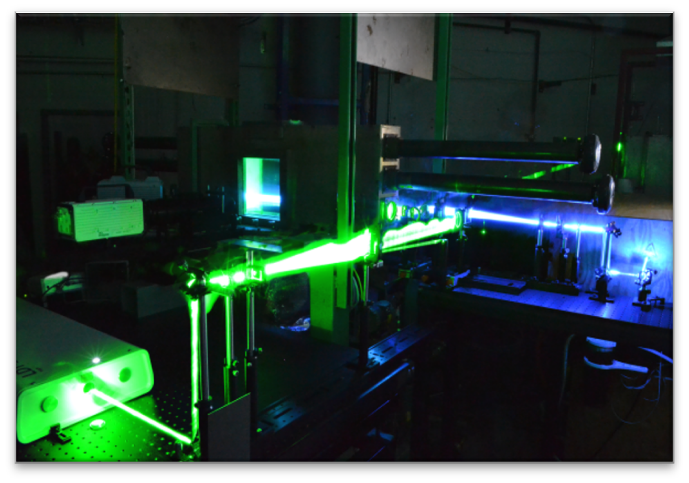
Understanding what is happening inside of a gas turbine or rocket combustor requires data... but how do you measure things inside of a such a system? While physical probes can be useful in some situations, they change the flow, do not survive well, can only measure limited quantities, have poor spatial and temporal resolution, etc.
At the Ben T. Zinn Lab, we use light (mostly from lasers) to probe the internal workings of combustion systems. Different techniques can be used to measure different aspects of the flow; we also develop new techniques if when needed. Many of the techniques use pulsed lasers to effectively "freeze" the flow at an instant in time. Moreover, many of these pulsed laser techniques can be repeated at kilohertz (or even megahertz) rates, allowing measurement of the time evolution of the flow. Some diagnostics techniques commonly used in the lab include:
- Particle image velocimetry (PIV) -- including stereoscopic PIV and tomographic PIV -- to measure velocity fields.
- Planar laser induced fluorescence (PLIF) of various minor chemical species to measure their distribution in the flow (PLIF also can be used to measure temperature in some situations).
- Rayleigh scattering -- including filtered Rayleigh scatting -- to measure number density, mixing, and temperature.
- Raman scattering to measure various major chemical species.
- Laser induced phosphorescence thermometry to measure gas and surface temperatures.
- Laser absorption spectroscopy (LAS) -- including tomographic LAS -- to measure species concentrations and temperature.
- Various forms of holography to measure multi-phase flows.
- Laser induced incandescence to measure particulates.
- Terahertz time domain spectroscopy and Thomson scattering to measure plasma properties.
- Laser Doppler and phase Doppler anemometry to measure velocities and droplet sizes.
- Various forms of interferometry to measure thermodynamic and optical properties.
- Chemiluminesence measurements.
In addition to these diagnostics, the lab is equipped with an extensive suite of probe based measurements to sample exhaust gases, measure pressure dynamics, etc.
Ongoing research on combustion diagnostics aims to expand measurement capabilities to new quantities and/or conditions of interest, such as higher pressures. For example, the figure below shows a unique system that was designed and built to study elastic light scattering from high-pressure gases, which is necessary to transition filtered Rayleigh scattering to aerospace-relevant systems.

Research groups working in this area:
- Prof. Ellen Mazumdar
- Prof. Adam Steinberg
